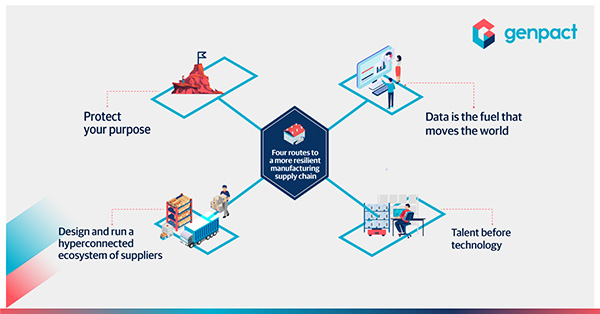Seeking a resilient, hyperconnected supply chain? Learn how data, tech, and talent drive sustainable growth for your enterprise.
By Anil Nanduru, Global Business Leader, High Tech and Manufacturing, Genpact
What does it take for a product to become a memorable experience for your customers? It takes a resilient, agile, and hyperconnected supply chain. Sixty-three % of companies surveyed by Bain & Company across different industries rank supply chain resiliency as a top goal compared to other business objectives. But the interplay of markets, geopolitical shifts, labor crunches, technological advancements, and changing consumer dynamics doesn’t make it easy. With manufacturers under constant pressure to reconsider their tactics, how can supply chain performance be elevated? How can your supply chain drive sustainable growth? Who should you partner with? Where to begin?

Thanks to the power of data, technology, AI, and analytics, you can architect a shock-resistant supplier ecosystem that thrives in the face of disruptions. You might need to go back to your drawing board but focusing on the following four areas will get you closer to your supply chain vision.
Leading manufacturers will continue to embrace the move to servitization. Creating value for customers looking for personalization, ethical choices, and flexibility requires the creation of distinctive experiences. It will be a battle between internal and external stakeholder expectations. And there is only one way to win. Enable end-to-end supply chain visibility through data, technology, and talent. This way, manufacturers can mitigate risks, drive operational efficiencies, optimize inventory management, and enhance customer satisfaction levels.

Anil Nanduru is the Global Business Leader for Genpact’s High Tech and Manufacturing (HMS) business. In this role, Anil serves major clients in software, electronics, and internet services as well as those in manufacturing, automotive, transportation, hospitality, and media industries. Anil also leads all Genpact initiatives in Japan and Germany.
In this episode, I sat down with Beejan Giga, Director | Partner and Caleb Emerson, Senior Results Manager at Carpedia International. We discussed the insights behind their recent Industry Today article, “Thinking Three Moves Ahead” and together we explored how manufacturers can plan more strategically, align with their suppliers, and build the operational discipline needed to support intentional, sustainable growth. It was a conversation packed with practical perspectives on navigating a fast-changing industry landscape.